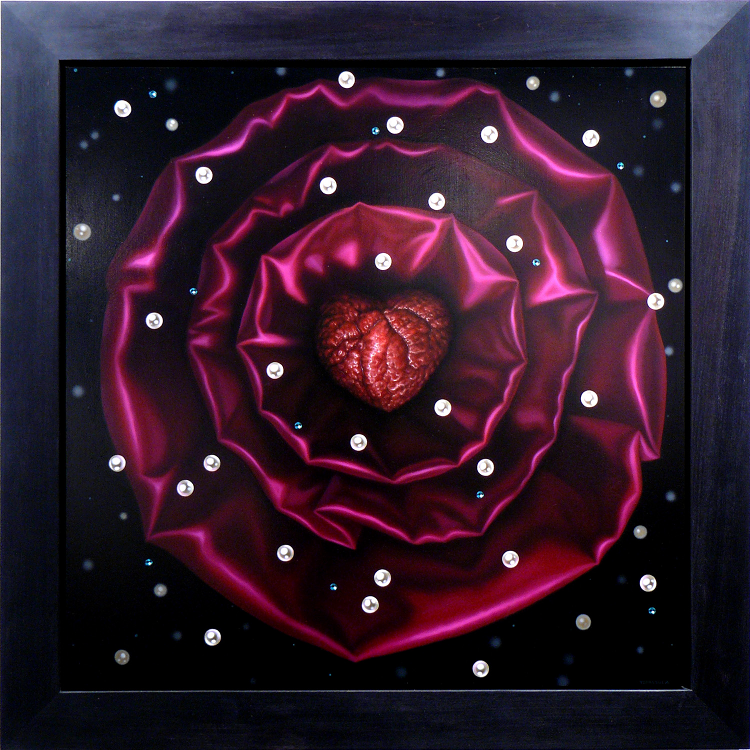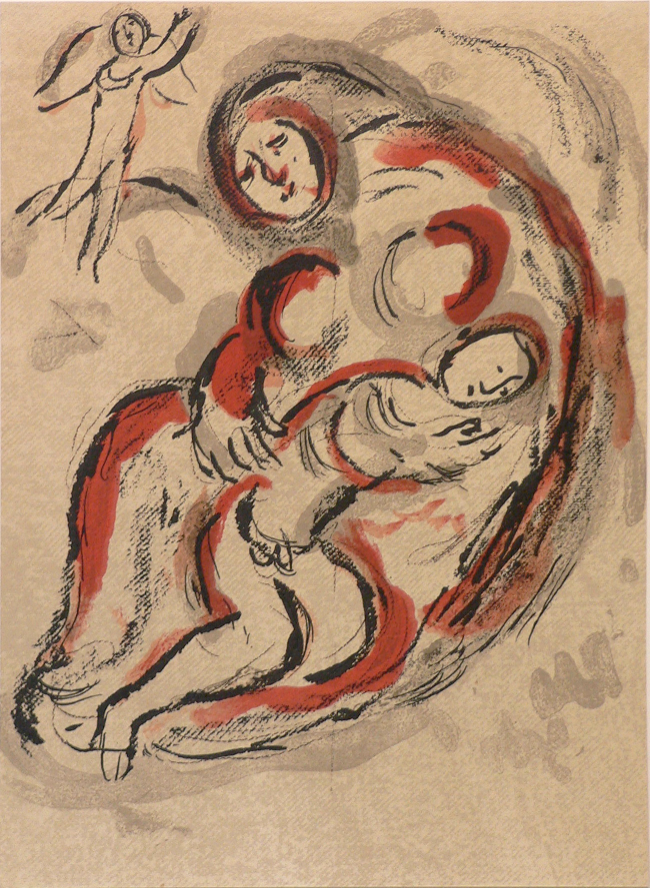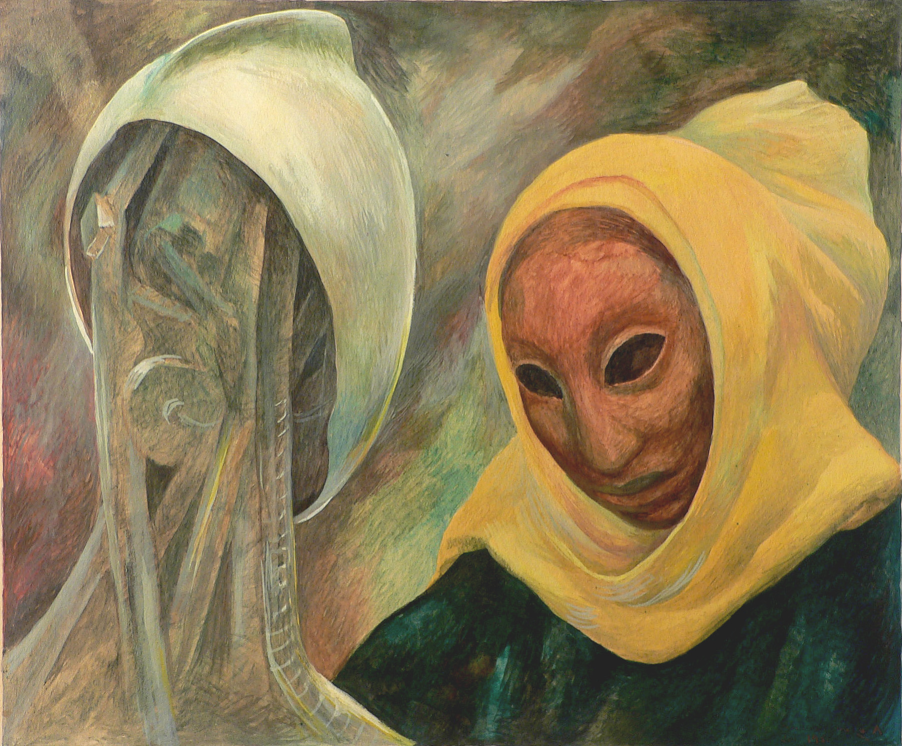
Embracing Our Differences: Works from the Permanent Collection
December 16, 2023 - February 18, 2024
East Gallery
Embracing Our Differences invites you to explore our Permanent Collection through the diverse lenses of artists from various nationalities and ethnicities. This exhibition celebrates the richness of our global artistic heritage, showcasing a curated selection of works that transcend cultural boundaries.
From prints to blown glass, these pieces reflect the universal themes that connect us as humans. Through diverse mediums and styles, this collection emphasizes the unique perspectives of individual artists while highlighting the common threads that bind us together.
Featured Work
-
![]()
About Myths
Oil. Preston Jackson. American, b. 1944.
100th Anniversary Purchase from the Mickey Shook Memorial Fund. 2009.07.
Known for his attention to detail in his finely crafted figurative sculptures, Preston Eugene Jackson was born on March 1, 1944, in Decatur, Illinois. He received his BFA from Southern Illinois University in Carbondale and his MFA from the University of Illinois at Urbana. He taught Painting and Drawing at Millikin University and then moved on to Western Illinois University where he taught Sculpture, Painting, and Drawing for the next 17 years. In 1989, Preston accepted a position as a tenured professor of sculpture at the School of the Art Institute of Chicago, where he still teaches. He has served as chair of the department and head of the Figurative Area of the Sculpture Department. He is now a professor emeritus at SAIC and a visiting artist at Bradley University. Preston’s large-scale outdoor sculptures, as well as his smaller bronze pieces, have been exhibited widely in the U.S.
In 1995, Jackson began the development of an art complex along the riverfront in downtown Peoria, Illinois. The Contemporary Art Center of Peoria is devoted to exhibiting the art of a broad spectrum of local, regional, and nationally acclaimed artists and furthering art education in the area.
-
![]()
Hagar in the Desert From "The Bible"
Color Lithograph. 1960. Marc Chagall. Russian, 1887-1985.
Anonymous Gift, 1981.13.
Marc Chagall was born in Belarus on July 7, 1887. Although born in Belarus, he was also considered a French painter, draughtsman, printmaker, designer, sculptor, ceramicist and writer. A prolific artist, Chagall excelled in the European tradition of subject painting and distinguished himself as an expressive colorist. His work is noted for its consistent use of folkloric imagery and its sweetness of color.
Chagall went to St. Petersburg in 1907, entering a minor art school and working as a sign painter. The foundations of Russian art and the sign painter’s technique were evident throughout his work. Though he preferred to be known as a Belarussian artist, following the exile from the Soviet Union in 1923, Chagall was recognized as a significant figure of the Ecole de Paris, especially in the late 1920s and the 1930s. He was associated with the avant-garde circle of Delaunay, Modigliani, and Chaim Soutine. His childlike figures and objects, distorted in scale and often floating upside down in space, influenced the surrealists.
During World War II, Chagall lived in the USA, where he designed ballet sets and costumes and subsequently worked on mosaics and tapestries for the Israeli Knesset building (1966). Other achievements included the costumes and decor for Stravinsky’s The Firebird (1945), stained-glass windows, and murals.
Marc Chagall returned to France after the war and, along with Picasso, was the only painter to have an exhibition at the Louvre during his lifetime. Chagall died in Saint-Paul-de-Vence, Alpes-Maritimes, on March 28, 1985.
The artist chose lithography as a print medium to explore his mystical world of lovers, musicians, and artists. Working directly on the printing plate, Chagall’s spontaneity of brushstrokes, drawn lines, and lush color resulted in some of the twentieth Century’s most highly sought-after lithographs.
-
![]()
Usual Suspects
Ceramic. Joe Rohrman. American, b. 1950.
Purchase from the Mickey Shook Memorial fund. 2017.7.
Joe Rohrman was born in Indianapolis, Indiana on January 17, 1950. He graduated from the John Herron School of Art, earning a BS in Arts in Crafts in 1975 and his MAE in 1980 from Indiana University. Rohrman was an accomplished high school art educator from 1975 to 2005. During his tenure, he was recognized as the ‘Educator that has most influenced the Academic Excellence of Franklin Central High School Students’ five times and the ‘Shining Star Nominee Award’ for excellence in teaching.
During his artistic career, Rohrman created functional and nonfunctional sculptures using various low- and high-fired clays, glazes, and stains. He explored various themes during that time but continuously returned to his fascination with people. Over time, he has created a generic cast of characters loosely based on people he observed. Rohrman’s subjects are familiar to everyone and represent his vision of everyday life. He considers himself an advocate for the ordinary. The inspiration for his clay figures has always been ordinary people in everyday settings and sometimes in quirky situations. Rohrman attempts to show character in an individual through exaggerated facial expressions, body proportions, and subtle mannerisms. His works range from the tragic to the whimsical and lighthearted. They all have a presence about them that viewers can connect with.
“My art isn’t going to change the world, nor is that my goal. It’s my hope that what I create can entertain, and, in this case, draw attention to a segment of society that is most likely to be swept under the run.”
-
![]()
Mechanical Age
Gouache. Guillermo Meza. Mexican, 1917-1997.
Gift of Professor and Mrs. Edward Stowe Akeley. 1995.28.
Of Tlaxcalan Indian descent, Meza left school at fourteen to become an apprentice in his father’s tailor shop. He attended Worker’s Night School in Ixtapalapa until 1937 when his teacher took him to Morelia as his assistant. In Mexico City, by 1938, Meza was “discovered” by Diego Rivera, who brought him to the attention of Galeria de Arte Moderno. They gave him his first solo exhibition. His “expressionist-surrealist” paintings, on themes often drawn from Indian mythology, have associated him with artists like Frida Kahlo and Agustin Lazo.
-
![]()
Music of Chance II
Oil, 2005. Maria Tomasula. Mexican American, b. 1958.
100th Anniversary Purchase from the Connie and Richard Grace Collection Fund. 2009.03.
Maria Tomasula is the Michael P. Grace Professor of Art at the University of Notre Dame, where she teaches painting and drawing. She received her MFA from Northwestern University and her BFA from the University of Illinois at Chicago.
Maria Tomasula came of age as an artist during the heyday of anti-aestheticism, but she refused to allow that philosophy to smother her natural love of the world of the sense. Drawing from her personal history as the child of Mexican immigrants, she embraced the bleeding hearts, dancing skeletons, and rose-encrusted MAdonnas of Mexican folk art, motifs born of a marriage of native-MExican and Spanish-colonial traditions. Her art shares the exuberant excess of the spiritual energies embedded in the material world.
Her paintings present arrangements of flowers, skulls, butterflies, jewels, birds, and human hearts painted with such fidelity to nature that they assume an almost hallucinogenic quality. Deliberately eschewing visible brushwork, Tomasula presents unblemished surfaces through which viewers may glimpse as if in a mirror or through the still surface of a lake, masses of meticulously realized emblems of natural and man-made abundance. Light glances off these objects in a way that emphasizes their dimensionality, while the colors are as rich and seductive as the bluest sky or the ripest plum.
-
![]()
Seated Female Figure | Figura Femenina Sentada
Oil. Rafael Coronel. Mexican, b. 1932.
Gift of Professor and Mrs. Edward Stowe Akeley. 1995.19.
The painter Rafael Coronel was born in Zacatecas, Mexico. He first pursued his art studies at the Instituto Nacional de Bellas Artes and then at La Esmeralda, which he left after only three months of study and promptly distinguished himself among the young painters of his generation. His first individual exhibition was held at the Galeria de Arte Mexicano in 1956. He was further honored as an established painter in 1959 when the National Institute of Fine Arts presented many of his works in a memorable individual show at the Palace of Fine Arts. Since 1959, he has had many individual exhibitions throughout Europe and the United States.
-
![]()
Purple Rose Vase
Blown and Appliqued Glass. Yuri Okamoto. Japanese American, b. 1978.
100th Anniversary Gift to the Museum from Sue and David Ebert. 2009.02.
Yuri Okamoto graduated in 2000 from Meisei University in Tokyo, Japan, with a Bachelor of Arts in Glass. Okamoto continued her education at The Corning Museum of Glass, with advanced studies of Venetian technique with William Gudenrath in 2006 and Elio Quarisa in 2007. She has been an active glass blower in Indianapolis, Indiana since 2003.
“I am always thinking about how I can make my piece unique and exciting,” said Okamoto. “I put a lot of my personality and passion into each piece. I hope someone can enjoy my piece the same way I did when I was making it.” Okamoto’s work has been featured at the Indianapolis Children’s Museum.







